I am often asked, if I had to choose, which would be the most important assessments for teachers of the deaf/hard of hearing to routinely use during initial or triennial assessments.
- Assessments that reflect unique needs of our students
- Assessments to tease out performance issues in students who are ‘okay’ academically
- Assessments that will be helpful in planning intervention
Biggest areas of vulnerability are: speech perception, listening comprehension, syntax, morphology, memory, phonological awareness, conversational use of language, pragmatic language, ‘Swiss cheese’ language.
Collaborate with your IEP team SLP: Tests need to be chosen that will evaluate syntax, morphology along with receptive/expressive language and conversational or social communication skills. Some tests are: CASL, CASLS, TOLD, TACL, CELF-V. Using test combinations to also identify issues with phonemic awareness and pragmatics/social language is important.
1. Determine level of communication access in the classroom – a necessity!
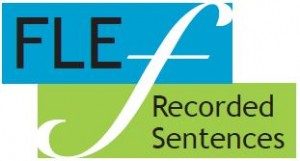 For ages 6-18
For ages 6-18
15 minutes to administer
Digital audio files – Use from CD or copy to your computer or phone
Perform all 8 conditions: Close/Far, Auditory only/ Auditory + Speechreading, Quiet/Noise (in +5 S/N classroom noise)
Continuous recording allows you to finish an 8 condition FLE in 10-15 minutes. Uses 5-word HINT sentences. Comes with computer fillable response form and auto calculating summary. Administration of the FLE can be adapted for SimCom/TC users. EVERY student with hearing loss who has useable residual hearing should have an FLE at least triennially.
2. What does s/he comprehend? – typical classroom language
Ages 6-11, Grades 1-6 or Adolescent version: Ages 12-18, Grades 6-12
35-40 minutes to administer
Subtests: Main Idea, Details, Reasoning, Vocabulary, Understanding Messages. The Listening Comprehension Tests focus on:
- Summarizing and Sequencing
- Participating in Discussions
- Following Directions
- Understanding Language Concepts
- Problem Solving and Predicting
- Listening for Meaning
RESULTS ARE PREDICTIVE OF HOW WELL A STUDENT WILL BE ABLE TO FUNCTION IN THE CLASSROOM.
Can be administered through amplification (no speechreading) and/or via visual communication/ASL.
3. What does s/he comprehend? – deeper language
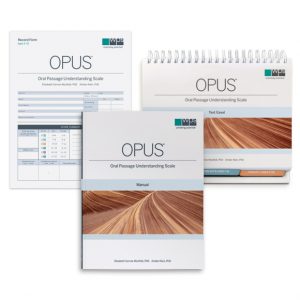 For ages 5 to 21 years
For ages 5 to 21 years
10 to 20 minutes to administer
OPUS identifies how well a person can integrate and apply knowledge in three structural categories of language:
- Lexical/Semantic: knowledge and use of words and word combinations
- Syntactic: knowledge and use of grammar
- Supralinguistic: knowledge and use of language in which meaning is not directly available from the surface lexical and syntactic information.
OPUS IS SENSITIVE TO FUNCTIONAL COMPREHENSION AND SYNTAX ISSUES. Can be administered auditorilly and/or via visual communication/ASL. Results of OPUS and the Listening Comprehension Test provide a clear reflection of daily comprehension ability and needs for planning. Listening comprehension is a higher order auditory development skill. Evaluation must occur to determine each student’s specific abilities and needs along the hierarchy of auditory skill development (such as evaluating with the SPICE).
4. How well does s/he interact with others? – social language use
A. If the student was found to have language within average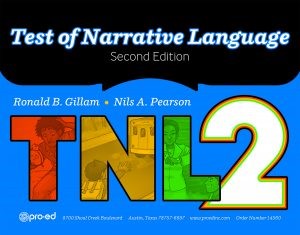
For ages 4 to 16 years
15 to 20 minutes to administer
Test of Narrative Language 2 identifies our student’s issues carrying on conversations, relating experiences. No transcription required.
- a functional assessment of narrative comprehension and narrative production;
- a measure of the ability to comprehend and produce three types of stories: a script, a personal narrative, and a fictional narrative;
- a system for scoring oral narratives that does not require clinicians to transcribe the stories;
- a normative test with clear, well-organized norms tables and administration procedures, as well as an easy-to-use record form; and
- a fair and equitable assessment of narrative discourse for all children.
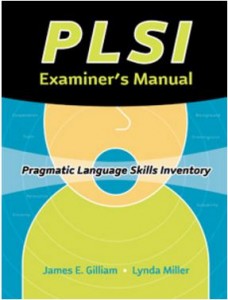 B. If pragmatic language was not evaluated (thoroughly) by the SLP
B. If pragmatic language was not evaluated (thoroughly) by the SLP
Obtain information from the classroom teacher about how well the student uses social language.
Takes classroom teachers 5-10 minutes to complete.
PLSI for ages 5 to 13 years
Students with hearing loss often have a 3+ delay in pragmatic language!
PLSI has 3 subscales:
- Personal Interaction Skills
- Social Interaction Skills
- Classroom Interaction Skills
- Clear cut-off scores
- Guidelines for interpretation
- Useful diagnostic instrument
Need to dig deeper? Use the Social Language Development Test – Elementary
5. How does s/he process language?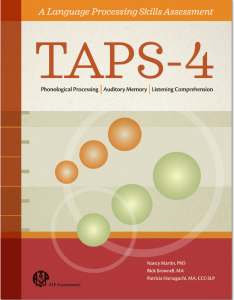
Ages 5 to 21 years
<60 minutes to administer>
The TAPS-4 provides information about language processing and comprehension skills across three intersecting areas: phonological processing, auditory memory and listening comprehension.
These areas underpin the development of effective listening and communication skills and are critical to the development of higher order language skills, including literacy skills.
Phonological Processing Index:
- Word (Pair) Discrimination: Assesses ability to discriminate whether a given word pair is the same or different
- Phonological Deletion: Assesses ability to manipulate phonemes within words
- Phonological Blending: Assesses ability to synthesize a word given the individual phonemes
- Syllabic Blending (Supplemental): Assesses ability to synthesize a nonsense word given the individual syllables
Auditory Memory Index:
- Number Memory Forward: Assesses ability to recall an auditory sequence of numbers in the given order
- Word Memory: Assesses ability to recall an auditory sequence of words in the given order
- Sentence Memory: Assesses ability to recall a spoken sentence
- Number Memory Reversed (Supplemental): Assesses ability to recall a reverse auditory sequence of numbers
Listening Comprehension Index:
- Processing Oral Directions (without background noise): Assesses ability to process and recall oral directions when presented in quiet listening conditions
- Auditory Comprehension: Assesses ability to comprehend oral language at the sentence and narrative level, including literal recall, inference, and higher order language tasks such as idioms and figurative language
- Auditory Figure-Ground (Processing Oral Directions with 4-speaker babble background noise) (Supplemental): Assesses ability to process and recall oral directions when presented with competing background noise
Assesses 5 narrow abilities across 3 broad skill areas as defined in the CHC theory of cognitive abilities:
Short-Term Memory: Memory Span (MS); Working Memory Capacity (MW)
Auditory Processing: Phonetic Coding (PC); Resistance to Auditory Stimulus Distortion (UR)
Comprehension-Knowledge: Listening Ability (LS)

